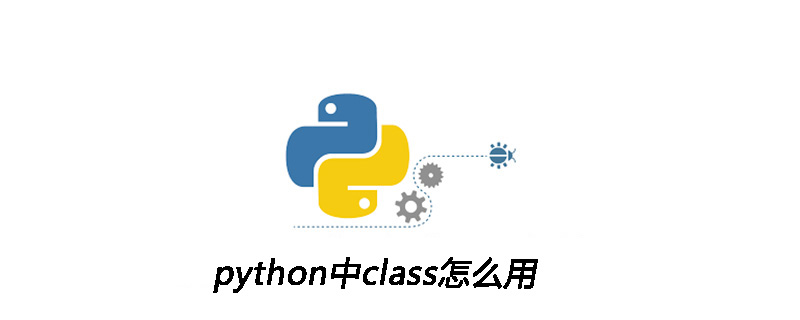python中class怎麼用
- 爱喝马黛茶的安东尼原創
- 2019-06-20 17:25:2226676瀏覽
Python程式設計中類別的概念可以比喻為某種類型集合的描述,如「人類」可以被看作一個類,然後用人類這個類定義出每個具體的人——你、我、他等作為其對象。類別也擁有屬性和功能,屬性即類別本身的一些特性,如人類有名字、身高和體重等屬性,而具體值則會根據每個人的不同;功能則是類別所能實現的行為,如人類擁有吃飯、走路和睡覺等功能。

特定的形式如下:
# 範例:類別的概念
class 人類:
名字= '未命名' # 成員變數
def 說話(內容): # 成員函數
print 內容# 成員變數賦初始值
##某人= 人類() # 定義一個人類物件某人 ##某人#某人.名字= "路人甲"
某人.說話('大家好') # 路人甲說話
>>> 大家好! # 輸出
>>> class pp:
... pass
...
>>> p = pp()
>>> print p
<__main__.pp instance at 0x00CA77B0>
>>>
列印了這個變數的型別。它告訴我們我們已經在__main__模組中有了一個Person類別的實例。
相關推薦:《
Python影片教學#範例程式二(__init__用法):說明:__init_ _方法在類別的物件被建立時,馬上運行。此方法用來對物件進行初始化。
>>> class Person: ... def __init__(self, name): ... self.name = name ... def sayHi(self): ... print 'Hello, my name is', self.name ... >>> p = Person('Swaroop') >>> p.sayHi() Hello, my name is Swaroop >>>範例程式三(__del__方法):
說明:__del__方法是在程式退出時呼叫的。
>>> class Person: ... population = 0 ... def __init__(self, name): ... self.name = name ... print '(Initializing %s)' % self.name ... def __del__(self): ... print '%s says bye.' % self.name ... Person.population -= 1 ... ... def howMany(self): ... if Person.population == 1: ... print 'I am the only person here.' ... else: ... print 'We have %d persons here.' % Person.population ... >>> A = Person('aa') (Initializing aa) >>> A.howMany() We have 0 persons here. >>> B = Person('bb') (Initializing bb) >>> B.howMany() We have 0 persons here. >>> ^Z aa says bye. bb says bye.
Python中定義並使用類別的形式為:class 類別名稱[(父類別名稱)]:[成員函數及成員變數],類別名為這個類別的名稱,而父類名為可選,但定義父類別名稱後,子類別則擁有父類別的對應屬性和方法。用類別定義成物件時,會先呼叫__init__建構函數,以初始化物件的各屬性,類別的各屬性(成員變數)都可以在建構函式中定義,定義時只要加上物件指標就好了。而在物件銷毀時,則會呼叫__del__析構函數,定義類別的成員函數時,必須預設一個變數(類似C 中的this指標)代表類別定義的物件本身,而這個變數的名稱可自行定義,下面例子將使用self變數表示類別物件變數。
class CAnimal:
name = 'unname' # 成员变量
def __init__(self,voice='hello'): # 重载构造函数
self.voice = voice # 创建成员变量并赋初始值
def __del__(self): # 重载析构函数
pass # 空操作
def Say(self):
print self.voice
t = CAnimal() # 定义动物对象t
t.Say() # t说话
>> hello # 输出
dog = CAnimal('wow') # 定义动物对象dog
dog.Say() # dog说话
>> wow # 输出Python程式設計中類別可以承繼父類別屬性,形式為class 類別名稱(父類),子類別可以繼承父類別的所有方法和屬性,也可以重載父類別的成員函數及屬性,須注意的是子類別成員函數若重載父類別(即名字相同),則會使用子類成員函數
class CAnimal:
def __init__(self,voice='hello'): # voice初始化默认为hello
self.voice = voice
def Say(self):
print self.voice
def Run(self):
pass # 空操作语句(不做任何操作)
class CDog(CAnimal): # 继承类CAnimal
def SetVoice(self,voice): # 子类增加函数
SetVoice self.voice = voice
def Run(self,voice): # 子类重载函数Run以上是python中class怎麼用的詳細內容。更多資訊請關注PHP中文網其他相關文章!
陳述:
本文內容由網友自願投稿,版權歸原作者所有。本站不承擔相應的法律責任。如發現涉嫌抄襲或侵權的內容,請聯絡admin@php.cn
上一篇:python怎麼統計文本中的字頻下一篇:python怎麼統計文本中的字頻

